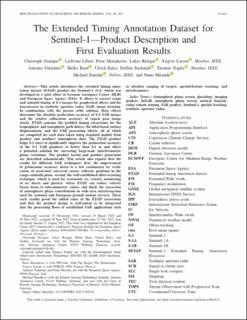| dc.contributor.author | Gisinger, Christoph | |
| dc.contributor.author | Libert, Ludivine | |
| dc.contributor.author | Marinkovic, Petar | |
| dc.contributor.author | Krieger, Lukas | |
| dc.contributor.author | Larsen, Yngvar | |
| dc.contributor.author | Valentino, Antonio | |
| dc.contributor.author | Breit, Helko | |
| dc.contributor.author | Balss, Ulrich | |
| dc.contributor.author | Suchandt, Steffen | |
| dc.contributor.author | Nagler, Thomas | |
| dc.contributor.author | Eineder, Michael | |
| dc.contributor.author | Miranda, Nuno | |
| dc.date.accessioned | 2023-03-30T12:40:36Z | |
| dc.date.available | 2023-03-30T12:40:36Z | |
| dc.date.created | 2022-09-16T14:26:05Z | |
| dc.date.issued | 2022 | |
| dc.identifier.citation | IEEE Transactions on Geoscience and Remote Sensing. 2022, 60 . | en_US |
| dc.identifier.issn | 0196-2892 | |
| dc.identifier.uri | https://hdl.handle.net/11250/3061197 | |
| dc.description.abstract | This article introduces the extended timing annotation dataset (ETAD) product for Sentinel-1 (S-1) which was developed in a joint effort of German Aerospace Center (DLR) and European Space Agency (ESA). It allows to correct range and azimuth timing of S-1 images for geophysical effects and for inaccuracies in synthetic aperture radar (SAR) image focusing. In combination with the precise orbit solution, these effects determine the absolute geolocation accuracy of S-1 SAR images and the relative collocation accuracy of repeat pass image stacks. ETAD contains the gridded timing corrections for the tropospheric and ionospheric path delays, the tidal-based surface displacements, and the SAR processing effects, all of which are computed for each data taken using standard models from geodesy and auxiliary atmospheric data. The ETAD product helps S-1 users to significantly improve the geolocation accuracy of the S-1 SAR products to better than 0.2 m and offers a potential solution for correcting large-scale interferometric phase variations. The product layout and product generation are described schematically. This article also reports first the results for different SAR techniques: first, the improvement in geolocation accuracy down to a few centimeters by verification of accurately surveyed corner reflector positions in the range–azimuth plane; second, the well-established offset-tracking technique, which is used for systematic ice velocity monitoring of ice sheets and glaciers, where ETAD can reduce velocity biases down to subcentimetric values; and third, the correction of atmospheric phase contributions in wide-area interferograms used for national and European ground motion services. These early results proof the added value of the ETAD corrections and that the product design is well-suited to be integrated into the processing flows of established SAR applications such as absolute ranging of targets, speckle/feature tracking, and interferometry. | |
| dc.language.iso | eng | en_US |
| dc.relation.uri | https://ieeexplore.ieee.org/stamp/stamp.jsp?tp=&arnumber=9841598 | |
| dc.rights | Navngivelse 4.0 Internasjonal | * |
| dc.rights.uri | http://creativecommons.org/licenses/by/4.0/deed.no | * |
| dc.title | The Extended Timing Annotation Dataset for Sentinel-1-Product Description and First Evaluation Results | en_US |
| dc.title.alternative | The Extended Timing Annotation Dataset for Sentinel-1-Product Description and First Evaluation Results | en_US |
| dc.type | Peer reviewed | en_US |
| dc.type | Journal article | en_US |
| dc.description.version | publishedVersion | |
| cristin.ispublished | true | |
| cristin.fulltext | original | |
| cristin.qualitycode | 2 | |
| dc.identifier.doi | 10.1109/TGRS.2022.3194216 | |
| dc.identifier.cristin | 2052556 | |
| dc.source.journal | IEEE Transactions on Geoscience and Remote Sensing | en_US |
| dc.source.volume | 60 | en_US |
| dc.source.pagenumber | 22 | en_US |

